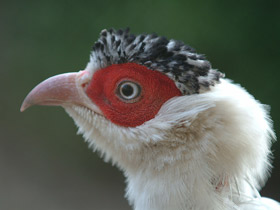The white eared pheasant Crossoptilon crossoptilon
The white eared pheasant is distributed in western China, southeastern Tibet, and the extreme northeastern India. This species is typical for the mountain forests of eastern Tibet and mostly inhabits light mixed, pine, and oak forests located at elevations of 3,200–4,200 m, and is also found in other forest types, at lower altitudes. Its range is limited to the forest zone edge at the level of rhododendron at elevation of 4,600 m. In the areas of the Yangtze River and its tributaries, this species of eared pheasants inhabits rocky mountain slopes covered with thickets of meadowsweet, wild rose, barberry and juniper. The wintering grounds are located in cultural landscape at elevation of 2,800 m above sea level. White plumage appears to be a form of adaptation to the severe climatic environment. All three species of eared pheasants are ecologically adapted to moving across the deep snow: they support themselves by their spread wings and tails, leaving characteristic tracks. Even in cold weather, the white eared pheasant is very active during the daytime, sometimes feeding from morning to evening. In winter, aggregations of up to 250 white eared pheasants can be seen, but usually size is not larger than 30 birds. During the breeding season, the birds of this species live in pairs. The mean body length is about 90 cm, the tail length is about 60 cm, the male’s body weight is 2,350 to 2,750 g, and the female’s body weight is 1,400 to 2,050 g.
In the wild, the white eared pheasant feed on tubers and roots in alpine meadows often in the company of yaks or other ungulates. To get the food the bird digs the rocky soil with its powerful bill and legs. In summer, these mountain birds can find strawberry and cranberry. The diet of nesting birds includes insects and other ground-dwelling invertebrates. In autumn, the pheasants mostly feed on juniper berries. The winter diet is based on pine needles, juniper berries, and the dry seed pods of iris and lily. During the most severe winter storms which may blow for weeks at a time, white eared pheasants may subsist upon pine needles and deer, rabbit and yak dung.
The nest is built on the ground, deeply in the wood, under fur trees or rock ledges. The female lays 6 to 9 eggs with the interval of 2 to 3 days. The incubation period is 24–25 to 28–29 days. Hatchlings weigh about 40 g, but they quickly develop, and already by the age of 10 days, their weight averages about 85 g. At 50 days, the birds weigh 600 g, reaching their adult size by the age of five months. The chicks of the white eared pheasants are considered semi-precocial, as they leave their nests only after they are able to walk.
















































